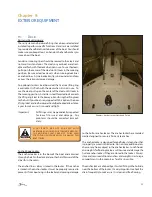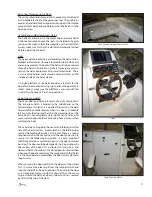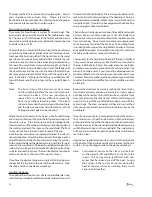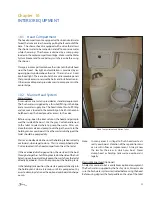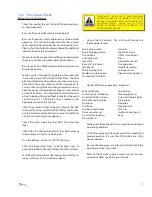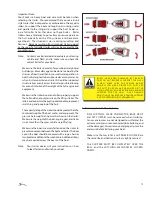
11.5 Required Safety Equipment
Besides the equipment installed on your boat by Scout, certain
other equipment is required by the U.S. Coast Guard to help
ensure passenger safety. Items like a sea anchor, working an-
chor, extra dock lines, flare pistol, life vests, a line permanently
secured to your ring buoy, etc. could at some time save your
passengers’ lives, or save your boat from damage. Refer to
the “Federal Requirements And Safety Tips For Recreational
Boats” pamphlet for a more detailed description of the required
equipment. You can also contact the U.S. Coast Guard Boating
Safety Hotline, 800-368-5647 or 800-336-2628 and 800-245-
2628 in Virginia, for information on boat safety courses and
brochures listing the Federal equipment requirements. Also,
check your local and state regulations.
The Coast Guard Auxiliary offers a “Courtesy Examination.”
This inspection will help ensure that your boat is equipped with
all of the necessary safety equipment.
The following is a list of the accessory equipment required on
your boat by the U.S. Coast Guard:
Personal Flotation Devices (PFDs)
PFDs must be Coast Guard approved, in good and service-
able condition, and of appropriate size for the intended user.
Wearable PFDs must be readily accessible, meaning you must
be able to put them on in a reasonable amount of time in an
emergency. Though not required, the Coast Guard emphasizes
that PFDs should be worn at all times when the vessel is un-
derway. Throwable devices must be immediately available for
use. All Scout boats must be equipped with at least one Type
I, II or III PFD for each person on board, plus one throwable
device (Type IV).
Visual Distress Signals
All Scout boats used on coastal waters, the Great Lakes, ter-
ritorial seas, and those waters connected directly to them, must
be equipped with Coast Guard approved visual distress signals.
These signals are either Pyrotechnic or Non-Pyrotechnic de-
vices.
Pyrotechnic Visual Distress Signals
Pyrotechnic visual distress signals must be Coast Guard ap-
proved, in serviceable condition, and readily accessible. They
are marked with a date showing the service life, which must
not have expired. A minimum of three are required. Some
pyrotechnic signals meet both day and night use requirements.
They should be stored in a cool, dry location. They include:
•
Pyrotechnic red flares, hand held or aerial.
•
Pyrotechnic orange smoke, hand-held or floating.
•
Launchers for aerial red meteors or parachute flares.
P Y R O T E C H N I C S A R E U N I V E R S A L L Y
R E C O G N I Z E D A S E X C E L L E N T D I S T R E S S
S I G N A L S. H O W E V E R, T H E R E I S P OT E N T I A L
F O R I N J U R Y A N D P R O P E R T Y D A M A G E I F
NOT PROPERLY HANDLED. THESE DE VICES
PRODUCE A VERY HOT FLAME AND THE RESIDUE
CAN CAUSE BURNS AND IGNITE FLAMMABLE
MATERIAL. PISTOL LAUNCHED AND HAND-
H E L D PA R A C H U T E F L A R E S A N D M E T E O R S
HAVE MANY CHARACTERISTICS OF A FIREARM
AND MUST BE HANDLED WITH CAUTION. IN
S O M E S TAT E S T H E Y A R E C O N S I D E R E D A
FIREARM AND PROHIBITED FROM USE. ALWAYS
BE EX TREMELY CAREFUL AND FOLLOW THE
MA N U FAC T U R E R ’S I N S T R U C T I O N S E XAC T LY
W H E N U S I N G P Y R O T E C H N I C D I S T R E S S
SIGNALS.
Non-Pyrotechnic Devices
Non-Pyrotechnic visual distress signals must be in serviceable
condition, readily accessible, and certified by the manufacturer
as complying with U.S. Coast Guard requirements. They
include:
•
Orange Distress Flag. (Day use only)
The distress flag is a day signal only. It must be at least
3 x 3 feet with a black square and ball on an orange
background. It is most distinctive when attached and
waved from a paddle or boat hook.
•
Electric Distress Light. (Night use only)
The electric distress light is accepted for night use only
and must automatically flash the international SOS distress
signal. Under Inland Navigation Rules, a high intensity
white light flashing at regular intervals from 50-70 times
per minute is considered a distress signal.
Fire Extinguishers
At least one fire extinguisher is re-
quired on all Scout boats. Coast Guard
approved fire extinguishers are hand-
portable, either B-I or B-II classifica-
tion and have a specific marine type
mounting bracket. It is recommended
that the extinguishers be mounted in a
readily accessible position.
Fire extinguishers require regular in-
spections to ensure that:
•
Seals & tamper indicators are not
broken or missing.
•
Pressure gauges or indicators read
in the operable range.
Summary of Contents for 262 Abaco
Page 1: ... Owner s Manual 262 Abaco Scout Boats Inc 2531 Hwy 78 West Summerville SC 29483 ...
Page 2: ... THIS PAGE WAS LEFT BLANK INTENTIONALLY Print Date 6 2007 Current ...
Page 4: ... THIS PAGE WAS LEFT BLANK INTENTIONALLY ...
Page 6: ... THIS PAGE WAS LEFT BLANK INTENTIONALLY ...
Page 10: ...10 THIS PAGE WAS LEFT BLANK INTENTIONALLY ...
Page 30: ...30 THIS PAGE WAS LEFT BLANK INTENTIONALLY ...
Page 40: ...40 THIS PAGE WAS LEFT BLANK INTENTIONALLY ...
Page 46: ...46 THIS PAGE WAS LEFT BLANK INTENTIONALLY ...
Page 52: ...52 THIS PAGE WAS LEFT BLANK INTENTIONALLY ...
Page 64: ...64 THIS PAGE WAS LEFT BLANK INTENTIONALLY ...
Page 70: ...70 THIS PAGE WAS LEFT BLANK INTENTIONALLY ...
Page 91: ...91 Appendix A SCHEMATICS Main Harness ...
Page 92: ...92 Battery Select Panel ...
Page 93: ...93 Battery Select Panel Wiring ...
Page 104: ...104 Appendix C MAINTENANCE SCHEDULE AND LOG ...
Page 105: ...105 MAINTENANCE LOG Hours Date Dealer Service Repairs ...
Page 106: ...106 MAINTENANCE LOG Hours Date Dealer Service Repairs ...
Page 107: ...107 MAINTENANCE LOG Hours Date Dealer Service Repairs ...
Page 108: ...108 MAINTENANCE LOG Hours Date Dealer Service Repairs ...
Page 109: ...109 MAINTENANCE LOG Hours Date Dealer Service Repairs ...
Page 113: ...113 THIS PAGE WAS LEFT BLANK INTEN TIONALLY ...
Page 119: ...119 ...
Page 120: ...120 Scout Boats Inc 2531 Hwy 78 West Summerville SC 29483 ...


